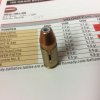Hey all. I'm just getting into reloading and could use some help.
I have the Lyman, and Hornady reloading books (both latest). Unfortunately neither has any load data on two of the bullets i have (9mm 135gn RNFP and FP).
I have 4 bullets in varying weights and styles (not very smart as i have to adjust my seating die each time i swap - live and learn). I'm looking forward to testing them out and figuring out which i like best in the long run and i'll stick with just that one (if can easily source).
Sorry to be long winded, my question is regarding COL, especially for the odd 135gn bullets. I have one set that is FP, and one that is RNFP.
I've only loaded up about 15 rounds of each(124 RNFP, 135 RNFP, & 147 RN are at 1.150-1.155) in varying charges in .2 increments (Titegroup 3.2, 3.4, 3.6). Hope to chrono these w/ a buddy tonight after work. Hodgdon shows min-max for 124 @ 3.6-4.1 so might be too light... I'll ensure all cycle my Sig P320 carry (3.9"), and chrono to get close to factory velocity. Then i'll adjust from there.
The recommended charges i've found have all been 135 LRN of titegroup 3.2-3.6 @ 1.150, how should i adjust COL for the 135 FP? I am working off someone else's load data and i know this is somewhat dangerous, so i will start at 3.2 and make sure no signs of pressure in primers before moving up to 3.4 and again to 3.6. These were using Bayou LRN, so my xtreme 135 FMJRNFP should seal less and be lower pressure (and velocity) so i hope i have some additional safety "wiggle room". The odd ducks will be the Hi-Tech coated LFP 135's i need to figure out COL. Haven't loaded any of these untili i figure this out.
Looking at the loaddata.com min-max are shown as 1.095 to 1.169 - so does that really mean that any 124/135/147 is OK anywhere in that range? That doesn't seem to jive with the COL's i'm seeing in the book for the regular 124/147 bullets.
Appreciate any info and enlightenment you can share!
I have the Lyman, and Hornady reloading books (both latest). Unfortunately neither has any load data on two of the bullets i have (9mm 135gn RNFP and FP).
I have 4 bullets in varying weights and styles (not very smart as i have to adjust my seating die each time i swap - live and learn). I'm looking forward to testing them out and figuring out which i like best in the long run and i'll stick with just that one (if can easily source).
Sorry to be long winded, my question is regarding COL, especially for the odd 135gn bullets. I have one set that is FP, and one that is RNFP.
I've only loaded up about 15 rounds of each(124 RNFP, 135 RNFP, & 147 RN are at 1.150-1.155) in varying charges in .2 increments (Titegroup 3.2, 3.4, 3.6). Hope to chrono these w/ a buddy tonight after work. Hodgdon shows min-max for 124 @ 3.6-4.1 so might be too light... I'll ensure all cycle my Sig P320 carry (3.9"), and chrono to get close to factory velocity. Then i'll adjust from there.
The recommended charges i've found have all been 135 LRN of titegroup 3.2-3.6 @ 1.150, how should i adjust COL for the 135 FP? I am working off someone else's load data and i know this is somewhat dangerous, so i will start at 3.2 and make sure no signs of pressure in primers before moving up to 3.4 and again to 3.6. These were using Bayou LRN, so my xtreme 135 FMJRNFP should seal less and be lower pressure (and velocity) so i hope i have some additional safety "wiggle room". The odd ducks will be the Hi-Tech coated LFP 135's i need to figure out COL. Haven't loaded any of these untili i figure this out.
Looking at the loaddata.com min-max are shown as 1.095 to 1.169 - so does that really mean that any 124/135/147 is OK anywhere in that range? That doesn't seem to jive with the COL's i'm seeing in the book for the regular 124/147 bullets.
Appreciate any info and enlightenment you can share!


